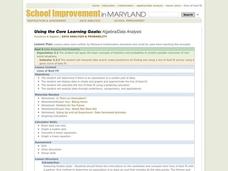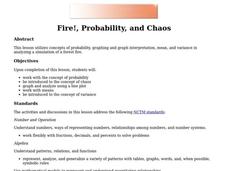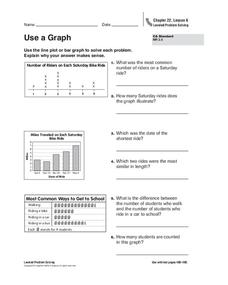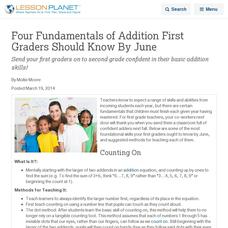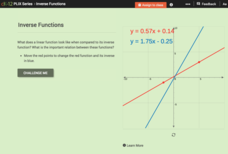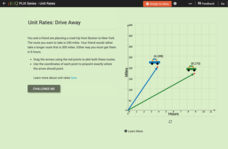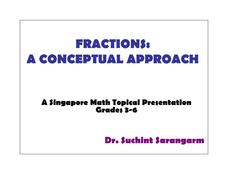Curated OER
Walking the Line
Students get an introduction to basic line drawing, including a definition, examples from art history, and three drawing exercises. They focus on drawing what they see rather than on drawing from memory.
Curated OER
Symmetry that is Basic and Beautiful
Pupils explore lines of symmetry. In this symmetry lesson, students divide and combine shapes along basic lines of symmetry. Pupils explore symmetry in real life objects.
Curated OER
Lines, Rays, and Angles
Third graders read "Pigs on the Ball" by Amy Axelrod and discuss the geometry concepts presented in the book. They use Twizzler sticks and pipe cleaners to represent lines, rays and angles.
Curated OER
Lines of Best Fit
Students explore the concept of line of best fit. In this line of best fit lesson, students find lines of best fit in examples about riding your bike home from school and dentistry. Students find two data points and find the line of best...
Curated OER
Human Number Line
Students compare different types of numbers. Each student is given a flashcard containing a decimal, percent, fraction or integer. Teams of students compete, in silence, to determine who can line up in numerical order correctly. They...
Curated OER
Line of Best Fit
Young scholars identify the line of best fit. In this statistics lesson plan, students collect and analyze data. They calculate the regression equations and identify the different types of correlation.
Curated OER
Fire!, Probability, and Chaos
Upper elementary and middle schoolers work with the concept of probability. They are introduced to the concept of chaos. Learners graph and analyze using a line plot, work with mean, and are introduced to the concept of variance.
Curated OER
Ruler and Compass Constructions
Fourth and fifth graders examine how to construct perpendicular lines and to bisect angles using rulers and compasses in this unit of lessons. They design a number of polygons using these methods.
Curated OER
Generate Measurement Data Word Problems
Bar and line graphs are an excellent way to visually analyze data: give your scholars practice both analyzing graphs and creating their own! First, they examine five basic bar graphs, indicating the number of squares on specific days....
Curated OER
Cloudy vs. Clear
Students analyze line plots. In this weather instructional activity using real NASA data, students discuss how weather affects the way the Earth is heated by comparing different line plots.
Curated OER
Fun Dance
"Fun Dance" is a 32-count dance of some very basic dance moves. Walking forward, walking backward, grapevines left, grapevines right, some punching arm moves, and some swimming arm moves. Put on some upbeat music and get movin'.
Curated OER
Linear Modelling of the Life Expectancy of Canadians
Middle and high schoolers explore the concept of linear modelling. In this linear modelling lesson, pupils find the line of best fit for life expectancy data of Canadians. They compare life expectancies of men and women, and find...
Curated OER
Use a Graph
Information is often presented in graph form. Can your youngsters read a basic bar or picture graph? Six word problems accompany three graphs. One graph is a bar graph and the other two are pictographs.
Curated OER
Number: Rounding Off and Approximating
Young mathematicians access a website that leads them through three activities that enable them to practice their rounding and estimation skills when it comes to numbers and math word problems. There is also a very good worksheet...
Curated OER
Signed Number Operations and Absolute Value
Students examine methods for adding, subtracting, multiplying and dividing signed numbers. The observe animated illustrations of each operation. students discover the basic meaning of absolute value. They compute problems after instruction.
Curated OER
Number in Geometry
Students use a number line to assist with their additions. They use a calculator to check for factors. Students are taught factors and multiples. They use array model of multiplication to define meaning. Students develop a wide range of...
Curated OER
Four Fundamentals of Addition First Graders Should Know By June
Send your first graders on to second grade confident in their basic addition skills!
Utah Education Network (UEN)
Subtracting Integers
Review the concepts of additive inverses and adding positive and negative integers. Relate understanding to the subtraction of integers. This is done with either the use of "Algeblocks" (any square or tile manipulative should do) or...
CK-12 Foundation
Inverse Functions
Provide a graphical view of inverses. Pupils manipulate points on a line and see the relationship of the graph with the graph of its inverse. Using the relationship between the graphs, scholars respond to questions concerning inverses...
EngageNY
Rational and Irrational Numbers
Back to the basics: learning how to add numbers. The 17th installment of a 35-part module first reviews addition techniques for rational numbers, such as graphical methods (number line) and numerical methods (standard algorithm). It goes...
Keynotes Education
The Recorder - B
Make some beautiful music with a lesson about playing the recorder! After learning some of the basic fingering positions and notes, have kids practice their skills with two easy songs.
CK-12 Foundation
Comparison of Unit Rates: Drive Away
Five questions make up an interactive that challenges mathematicians to compare unit rates. Word problems question scholars about two friends going on a road trip. Scholars manipulate two cars on a coordinate plane to help solve word...
CK-12 Foundation
Distance Between Two Points: Segment Addition
Examine the segment addition postulate through an online simulation activity. An interactive lesson allows scholars to manipulate points and watch as the lengths of segments change. Through their study, they are able to apply the Segment...
Curated OER
Fractions: A Conceptual Approach
If you are teaching fractions to elementary learners this year, this Singapore Math presentation is essential to your curriculum. It addresses several basic fractions concepts in conceptual terms and figures, making each idea accessible...





